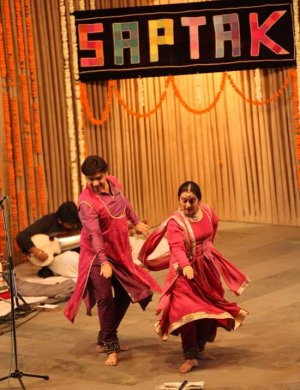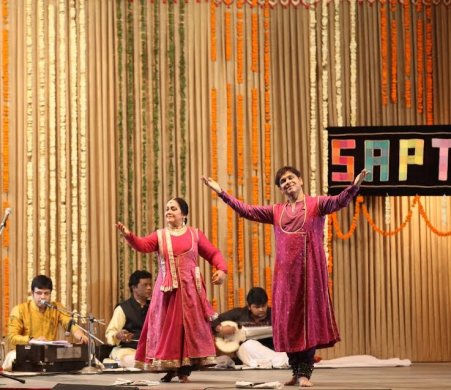
|   |

|   |
A setu between the tradition and the audience today - S.D. Desai e-mail: sureshmrudula@yahoo.co.in January 21, 2017 Being articulate is an advantage to a dancer. There was this year, four instead of only one dance performance at the 13-day annual Saptak Music Festival – three of Kathak, one of Bharatanatyam. Before Aanart directors and dancers Maulik Shah and Ishira Parikh on 9th January, the one and only Pt. Birju Maharaj and a promising young dancer of Kadamb Centre for Kathak, Rupanshi Kashyap had performed. “You’ve seen a dance performance with gahraiyaan in it and another with the tarvaraat of an emerging dancer. We’ll try,” Maulik added with communicative ease, “to be a setu, between the two.” They did. Their centre Aanart, incidentally, has always tried to link the tradition with the audience today.  His counterpart, as much in dance as in life, Ishira stood in the centre of the Saptak stage that has assumed by this 37th annual festival an aura, beaming with her characteristic smile, looking now at Maulik speaking and at the audience, from whom came across vibrations of a warm welcome and expectations. Bloom comes flying and sits on a performer’s face plucking quite a few years off it. Looking younger, the duo, dancing together for three decades now, lived up to their expectations and went beyond. In what looked an effortless flow, they developed two recurring motifs. The pleasing visual images of saayujya or togetherness are prototypical of Lord Shiva and Goddess Parvati. Maulik stands behind his better half on his left with his hand around her gently at the waist, her right hand hanging loose, face glowing. Among the visual images are also those of happy interactive glances even while one is in communication with the viewers. One of the country’s most lovable and talented dancing couples, they have always visually conveyed this togetherness in their performances as they do here at the festival. They remain constantly in an engaging nonverbal samvaad with each other and with the tabla player, pleasingly accompanied by the sound of ghunghroo. One a fountain of male energy bursting, the other a rivulet of flowing feminine grace, complement each other with the mellowness all their own.  The other delectable motif is auditory, which in its appeal becomes extrasensory. This has a thematic value for the performance specially prepared for the event. In elements like ginati, which Maulik clearly enunciates in words, they did not seem to present mathematical counts. Blending strong beats on the tabla with softer responses by the ghunghroo and their own irrepressibly expressive mood, they hold the audience spellbound and give them a feel of an exhilarating flow of laya. The creative process is lifted and put into a throbbing laya orbit analogous in a tiny way to the universal laya all arts seek to emulate. They demonstrated varying uthans, todas, tukdas and chakkars, mixing them with an elegant ascent of quick gradual rhythmic steps and their descent, the 13-beat taal Jaya, a delightful ride on the opening syllable of a rhythmic pattern sam, the innovative tera-mera mera-tera duet in splits of the 13 beats, the ghar-vaapasi to the 16-beat teen taal and a Taal Samuchchaya of dhamaar, teen taal, roopak and daadra. The dancers in their best expressive form in recent years offered a garland of flowers strung together between two devotional offerings Namah Shivaay and Yah binatee Raghuvir Gosaai in Prahar Vora’s voice accompanied by Sapan Anjaria and Ajay Solanki on the tabla, Hriday Desai on the sarod and Ikram Khan on the sarangi. It’s an offering to the contemporary audience as well of a rich tradition in their idiom undiluted in authenticity. Dr. S.D. Desai, a professor of English, has been a Performing Arts Critic for many years. Among the dance journals he has contributed to are Narthaki, Sruti, Nartanam and Attendance. His books have been published by Gujarat Sahitya Academy, Oxford University Press and Rupa. After 30 years with a national English daily, he is now a freelance art writer. |